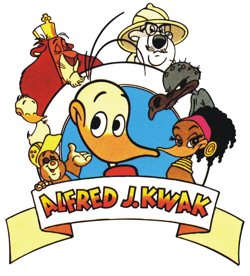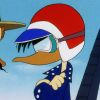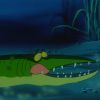Plaspoelpolder
| Plaspoelpolder | |
|---|---|
| Locations | |
 | |
| De Plaspoelpolder just before rainfall | |
| Level | Area |
| Country | Breed Rietland |
| First appearance | Episode 1 |
Name in different languages | |
| Dutch name | Plaspoelpolder |
| Japanese name | Unknown |
| German name | Unknown |
| English name | Unknown |
The Plaspoelpolder[note 1] is the pasture where Alfred Jodocus Kwak and his siblings were born. It is the place where his parents first met and also the home of Henk de Mol. Located in the country of Breed Rietland, the Plaspoelpolder was mostly quiet until the Beton Maatschappij began constructing Groot Speelgoed Land, a massive theme park, in its center. This development displaced many of the animals living in the area, leading many to emigrate to the neighborhood of Polderstad in Groot Waterland.[1][2]
Notable features
The Plaspoelpolder is a mostly flat and untouched natural area with no buildings. Several species of animal, including sheep, frogs, birds, ducks, and bees, live there in relative peace and quiet. The only sources of noise are the nearby busy road and the occasional fighter jet.[1] The Plaspoelpolder features numerous ditches and canals. One of these canals was traversed by Johan Sebastiaan Kwak and Henk de Mol in Johan's clog, which also served as a boat, shortly after they met under a willow just outside the Plaspoelpolder.[3][4]
In the vicinity of the Plaspoelpolder, there is also a park known as the Plaspoelpark, a place that Johnny Hollyday expressed interest in taking Anna van de Polder to[5].
A significant change occurred when project leader Olaf Nijlpaard secured funding from Alfons Rokodil to obtain permits for the construction of a large theme park, Groot Speelgoed Land, in the middle of the pasture. Inhabitants of the Plaspoelpolder were, according to Bart 'Beton' Bever, announced in the local free newspaper Plaspoelnieuws (lit. Plaspoel-news) and the Breedrietlandsche Bode (lit. Breed Rietland's Herald). This theme park became popular and caused many animals to need to emigrate to other countries[1][2][6][7].
History
Generally the Plaspoelpolder is full of wildlife. Animals that don't have buildings as a home and have nests and use clogs as homes. There are some predators lurking about that would eat eggs and small animals, like Rap de Kiekendief and Snel de Snoek[1]. Furthermore, there are some animals that have feuds, for example Schor de Kraai and Johan Sebastiaan Kwak[8]. Not all animals live here in harmony, but generally it is peaceful and quiet in de Plaspoelpolder.
When Olaf Nijlpaard got the funding to procure permits to build in de Plaspoelpolder, this changed. The building of Groot Speelgoed Land, funded by Alfons Rokodil and built by the Beton Maatschappij, displaced almost all of the animals. Schor would take his family to Groot Waterland as did Johan. Anna van de Polder's parents left for the south, splitting the family up. Even predators like Snel and Rap emigrated[9][10][2].
Inhabitants
-
Alfred Jodocus Kwak (moved away)
-
Alfred's brothers and sisters (moved away)
-
The great-great-great-grandmother of Amanda de Vlinder
-
Anna van de Polder (moved away)
-
Mevrouw Bij (moved away)
-
Mevrouw Bij's son (moved away)
-
 Anna's bossom friend Clara (moved away)
Anna's bossom friend Clara (moved away) -
 Clara's elderly parents (moved away)
Clara's elderly parents (moved away) -
Dolf de Kraai (moved away)
-
Henk de Mol (moved away)
-
Jan van de Polder (moved away)
-
Johan Sebastiaan Kwak (moved away)
-
Miriam Merel (moved away)
-
Schor de Kraai (moved away)
-
Snel de Snoek (moved away)
-
Rap de Kiekendief (moved away)
-
Willem Bij (moved away)
Appearances
TV Series
Audio
Books
-
De wonderlijke avonturen van Alfred J. Kwak: De zeven eieren (1989) (Dutch)
-
De wonderlijke avonturen van Alfred J. Kwak: Omnibus 1 (1989) (Dutch)
-
Alfred J. Kwak Mijn avontuurlijke leven (1991) (Dutch)
-
Alfred J. Kwak Filmstripboek Deel 1 (2006) (Dutch)
Production background

The name the Plaspoelpolder was never mentioned in the show, but regularly mentioned in several Dutch books. It does not include the tree where Henk de Mol and Johan Sebastiaan Kwak meet. The tree and the Plaspoelpolder are also divided by the busy road. It contains mostly flat pastures, some canals and small ditches one could use a boat to pass through. It also includes the tree under which Johan's living clog is mostly stationed during the first episode.
In 1989 Hans Bacher was tasked to make a variety of paintings to send to the studios in Japan for inspiration on how to draw the Dutch landscapes properly. Many of these ended up in the end titles of the animated series. Some of these depict very clearly what the Plaspoelpolder should look like.
One stylistic element specifically added by Harald Siepermann is the depiction of a jet plane flying over the quiet meadow at the beginning of the story, intended to disrupt the idyllic setting and introduce a sense of conflict to inform the world building[11].
There is a Plaspoelpolder in real life, however it's a business park in Rijswijk in the Netherlands.

Notes
- ↑ First named in the book De wonderlijke avonturen van de eend Alfred Jodocus Kwak: Goedemorgen, but remained unnamed in the animated series.
References
- ↑ 1.0 1.1 1.2 1.3 "De eieren". Alfred J. Kwak. Season 1. Episode 1. April 3, 1989. TV Tokyo.
- ↑ 2.0 2.1 2.2 "Het verjaardagsfeestje". Alfred J. Kwak. Season 1. Episode 2. April 10, 1989. TV Tokyo.
- ↑ "> van Veen, Herman (1989). De wonderlijke avonturen van de eend Alfred Jodocus Kwak: Goedemorgen. Artwork by Harald Siepermann & Hans Bacher. Soest: Harlekijn Uitgeverij. ISBN 9063860706. page 9
- ↑ "> van Veen, Herman (1989). De wonderlijke avonturen van Alfred J. Kwak: De zeven eieren [The wonderful adventures of Alfred J. Kwak: The seven eggs] (in Nederlands). Weert: Uitgeverij van Reemst, M&P bv. ISBN 9035901053. page 4
- ↑ van Veen, Herman; Holzhaus, Hanneke (1991). De Droom van Alfred Jodocus Kwak [The Dream of Alfred Jodocus Kwak] (in Nederlands). Soest, the Netherlands: Harlekijn, Westbroek. ISBN 9063860862. Page 85, according to Henk de Mol. In the animated series, Johnny Hollyday was shown not to speak.
- ↑ van Veen, Herman; Holzhaus, Hanneke (1991). De Droom van Alfred Jodocus Kwak [The Dream of Alfred Jodocus Kwak] (in Nederlands). Soest, the Netherlands: Harlekijn, Westbroek. ISBN 9063860862. Several pages include instances of other characters and animals leaving de Plaspoelpolder.
- ↑ van Veen, Herman (1989). De wonderlijke avonturen van de eend Alfred Jodocus Kwak: Goedemorgen. Artwork by Harald Siepermann & Hans Bacher. Soest: Harlekijn Uitgeverij. ISBN 9063860706. Page 32
- ↑ van Veen, Herman; Holzhaus, Hanneke (1991). De Droom van Alfred Jodocus Kwak [The Dream of Alfred Jodocus Kwak] (in Nederlands). Soest, the Netherlands: Harlekijn, Westbroek. ISBN 9063860862. Page 88
- ↑ van Veen, Herman (1989). De wonderlijke avonturen van de eend Alfred Jodocus Kwak: Goedemorgen. Artwork by Harald Siepermann & Hans Bacher. Soest: Harlekijn Uitgeverij. ISBN 9063860706. Page 32
- ↑ van Veen, Herman; Holzhaus, Hanneke (1991). De Droom van Alfred Jodocus Kwak [The Dream of Alfred Jodocus Kwak] (in Nederlands). Soest, the Netherlands: Harlekijn, Westbroek. ISBN 9063860862. Page 118 and 136
- ↑ Harald Siepermann (15 October 2005). "The first spread of Guten Morgen in Pierrot". alfredjkwak.blogspot.com.











